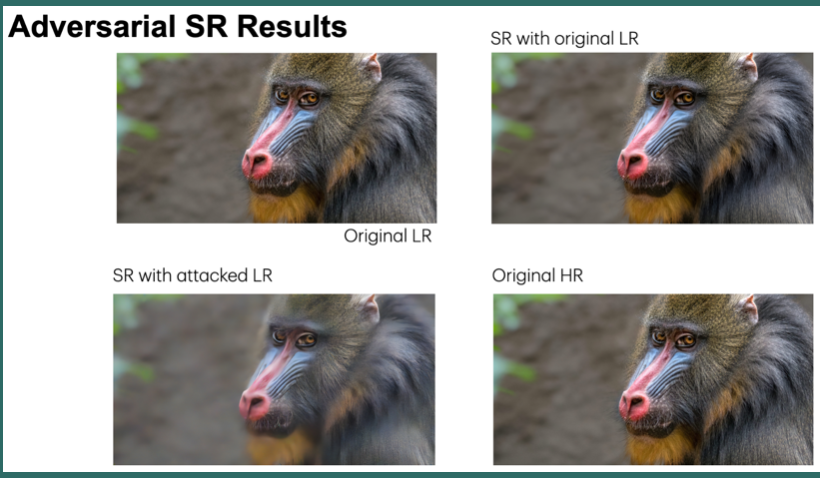
Machine learning and image enhancement models are prone to adversarial attacks, where inputs can be manipulated in order to cause misclassifications. While previous research has focused on techniques like Generative Adversarial Networks (GANs), there’s limited exploration of GANs and Synthetic Minority Oversampling Technique (SMOTE) in image super-resolution, and text and image classification models to perform adversarial attacks. Our study addresses this gap by training various machine learning models and using GANs and SMOTE to generate additional data points aimed at attacking super-resolution and classification algorithms. We extend our investigation to face recognition models, training a Convolutional Neural Network(CNN) and subjecting it to adversarial attacks with fast gradient sign perturbations on key features identified by GradCAM, a technique used to highlight key image characteristics of CNNs use in classification. Our experiments reveal a significant vulnerability in classification models. Specifically, we observe a 20% decrease in accuracy for the top-performing text classification models post-attack, along with a 30% decrease in facial recognition accuracy.

In the dynamic realm of image processing, coordinate-based neural networks have made significant strides, especially in tasks such as 3D reconstruction, pose estimation, and traditional image/video processing. However, these Multi-Layer Perceptron (MLP) models often grapple with computational and memory challenges. Addressing these, this study introduces an innovative approach using Tensor-Product B-Spline (TPB), offering a promising solution to lessen computational demands without sacrificing accuracy. The central objective was to harness TPB’s potential for image denoising and super-resolution, aiming to sidestep computational burdens of neural fields. This was achieved by replacing iterative processes with deterministic TPB solutions, ensuring enhanced performance and reduced load. The developed framework adeptly manages both super-resolution and denoising, utilizing implicit TPB functions layered to optimize image reconstruction. Evaluation on the Set14 and Kodak datasets showed the TPB-based approach to be comparable to established methods, producing high-quality results in both quantitative metrics and visual evaluations. This pioneering methodology, emphasizing its novelty, offers a refreshed perspective in image processing, setting a promising trajectory for future advancements in the domain.

The high-resolution magnetic resonance image (MRI) provides detailed anatomical information critical for clinical application diagnosis. However, high-resolution MRI typically comes at the cost of long scan time, small spatial coverage, and low signal-to-noise ratio. The benefits of the convolutional neural network (CNN) can be applied to solve the super-resolution task to recover high-resolution generic images from low-resolution inputs. Additionally, recent studies have shown the potential to use the generative advertising network (GAN) to generate high-quality super-resolution MRIs using learned image priors. Moreover, existing approaches require paired MRI images as training data, which is difficult to obtain with existing datasets when the alignment between high and low-resolution images has to be implemented manually.This paper implements two different GAN-based models to handle the super-resolution: Enhanced super-resolution GAN (ESRGAN) and CycleGAN. Different from the generic model, the architecture of CycleGAN is modified to solve the super-resolution on unpaired MRI data, and the ESRGAN is implemented as a reference to compare GAN-based methods performance. The results of GAN-based models provide generated high-resolution images with rich textures compared to the ground-truth. Moreover, results from experiments are performed on both 3T and 7T MRI images in recovering different scales of resolution.

With the prevalence of 3D scanners and 3D printers, manufacturing various 3D objects has become easier in recent years. When measuring the surface shape of an object using a 3D scanner, it is desirable to perform measurements at the highest possible resolution. However, there are many objects for which the resolution of commercial 3D scanners is insufficient. One solution to this problem is to apply super-resolution technology by measuring 3D data multiple times. It is crucial to align the 3D point clouds generated by multiple measurements accurately, but the conventional alignment methods are not accurate enough. This study aimed to improve the accuracy of the alignment process for 3D point clouds. The proposed method consists of the following four steps: (1) 3D point clouds are adaptively sampled. (2) A fast point feature histogram is used to extract features from the sampled point clouds. (3) The random sample consensus method is used to estimate an initial alignment. (4) The iterative closest point method is used to perform a precise alignment procedure. The feasibility of the proposed method is verified through experiments using real objects.

In this paper, a single image multi-scale super-resolution technique is proposed. The concept under study is the learning procedure between steps of amplification in order to predict the next high scale of resolution. The method integrates two different approaches for the prediction of a high resolution multi-scale scheme, a pure interpolation and a gradient regularization. In the first step a pure interpolation is carried out. It is used a prediction scheme with algebraic reconstruction through different scales to produce the high resolution output. In the last step, the residual blur is reduced by a gradient auto-regularization method. The gradients are adapted by using a weight in a neighbour. Precision of method can be controlled by the parameters of an algebraic reconstruction technique (ART). The proposed model avoids the fast decrease of the output resolution as the amplification factor increases. The proposed system was tested with a dictionary. Results show that the output image quality is improved despite of the increment of the scale factor.